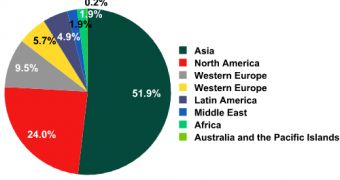Kaspersky has released its spam report for November 2012 and some of the numbers are encouraging.
The share of spam in email traffic has dropped by 5.1%, averaging out at 63%. Furthermore, compared to October, the number of phishing emails has decreased by around 50%.
On the other hand, when it comes to malware, the number of malicious software-containing emails has increased by 0.02% compared to the previous month.
When it comes to spam, unsolicited messages that focused on topics such as the holidays and natural disasters were highly prevalent. As always, pharmaceutical spam was as popular as ever.
In November, China and the US remained the number one sources of spam, the two of them being responsible for over half of all the world’s spam. They’re followed by India, Vietnam, Germany, Russia, Brazil, the UK and Taiwan.
The same two countries also top the chart when it comes to the sources of spam in Europe.
Most of the spam messages containing malware have been aimed towards the United States and Germany.
The Trojan-PSW.Win32.Tepfer malware family has been appointed as being the most common, three versions being present on the chart, including the password-stealing Trojan-PSW.Win32.Tepfer.cfwf – which is number one.
In the past month, phishing campaigns mostly targeted social networking sites (29%), financial organizations (20%), search engines, and online stores and e-auction sites.
“During the holiday season, Internet users should be cautious about opening emails that allegedly contain notifications from various stores, banks, and other financial systems,” Kaspersky’s Darya Gudkova noted.
“Users are warned against opening suspicious attachments from unknown senders, clicking on links allegedly leading to banking websites, and especially against entering any personal information such as bank card numbers, passwords, or usernames for payment accounts.”

 14 DAY TRIAL //
14 DAY TRIAL //